#crmdata
Explore tagged Tumblr posts
Text
How CRM Data Hygiene Can Boost Your Business
Don’t let bad data slow down your business! If your CRM data is messy or outdated, it’s time for a cleanup. Start with a thorough data audit to identify and fix common issues like duplicate records and inactive contacts. In this guide, we’ll show you the steps to maintain clean CRM data, from regular validation to setting up automated processes. Clean data leads to smarter decisions, more engaged leads, and a more efficient sales funnel.
Check out the full post: CRM Data Hygiene
#CRM#DataHygiene#SalesOptimization#LeadGeneration#BusinessGrowth#MarketingTips#DataManagement#MarketingStrategy#DigitalMarketing#CRMData#BusinessEfficiency#CleanData#CustomerEngagement#SalesFunnel#BusinessSuccess
0 notes
Text
✨ Want to know the secret to happier customers? Leverage your CRM data! Discover How to Use CRM Data to Improve Customer Satisfaction and create personalized experiences that boost loyalty and retention. 💼
In this blog, we dive into actionable strategies to make the most of your CRM system, helping your business deliver exceptional service and drive success.
#CRMSolutions#CustomerSatisfaction#CustomerRetention#BusinessSuccess#CRMData#CustomerExperience#VizionCX#Dubai#UAE
0 notes
Text
The Importance of CRM Data Cleansing Services in Enhancing Data Quality
In today's data-driven business landscape, Customer Relationship Management (CRM) systems serve as the backbone of effective customer management and engagement strategies. However, the efficiency and accuracy of CRM systems heavily depend on the quality of data they contain. Poor data quality can lead to a plethora of issues, including inaccurate insights, misguided decision-making, and compromised customer experiences. This is where CRM data cleansing services step in, playing a crucial role in enhancing data quality and maximizing the value derived from CRM investments.
Understanding CRM Data Cleansing Services
CRM data cleansing services encompass a range of processes aimed at identifying and rectifying inaccuracies, inconsistencies, and redundancies within CRM databases. These services employ advanced technologies, algorithms, and manual interventions to ensure that CRM data is accurate, complete, and up-to-date.
The Impact of Poor Data Quality
Before delving into the importance of CRM data cleansing services, it's essential to recognize the repercussions of poor data quality within CRM systems. Inaccurate or outdated customer information can result in failed marketing campaigns, missed sales opportunities, and diminished customer satisfaction. Moreover, it can erode trust in the organization's brand and undermine its reputation.
Enhancing Data Quality Through Cleansing Services
Identifying and Removing Duplicate Records: Duplicate records are a common issue in CRM databases, often leading to confusion and inefficiency. CRM data cleansing services employ sophisticated algorithms to detect and eliminate duplicate entries, ensuring that each customer is represented by a single, accurate record.
Standardizing Data Formats: Inconsistencies in data formats, such as variations in address formats or contact information, can hinder data analysis and segmentation efforts. Data cleansing services standardize data formats across the CRM system, facilitating seamless integration and analysis.
Validating and Enriching Data: Data cleansing services validate existing data to ensure its accuracy and completeness. Additionally, they enrich CRM databases by supplementing existing records with additional information obtained from reliable sources. This process enhances the depth and quality of customer insights available to the organization.
Updating Outdated Information: Customer information, such as contact details and preferences, can change over time. CRM data cleansing services regularly update outdated information, ensuring that CRM databases reflect the most current customer data available.
Ensuring Compliance with Data Regulations: With the proliferation of data privacy regulations, such as GDPR and CCPA, organizations must ensure compliance when handling customer data. CRM data cleansing services help organizations maintain compliance by adhering to data protection regulations and implementing robust data governance practices.
Benefits of CRM Data Cleansing Services
Improved Decision-Making: Accurate and reliable CRM data enables organizations to make informed decisions based on real-time insights and trends.
Enhanced Customer Experiences: Clean CRM data facilitates personalized interactions, leading to improved customer satisfaction and loyalty.
Increased Operational Efficiency: Streamlined CRM data sets reduce the time and resources spent on manual data entry, validation, and correction.
Maximized ROI on CRM Investments: By optimizing data quality, CRM data cleansing services ensure that organizations derive maximum value from their CRM investments.
Conclusion
In conclusion, CRM data cleansing services play a pivotal role in ensuring the accuracy, reliability, and relevance of CRM data. By addressing inaccuracies, inconsistencies, and redundancies within CRM databases, these services empower organizations to make informed decisions, deliver exceptional customer experiences, and maximize the return on their CRM investments. As businesses continue to recognize the importance of data quality in driving success, investing in CRM data cleansing services becomes imperative for staying competitive in today's dynamic marketplace.
0 notes
Text
A Complete Guide for Seamless Migration from Vtiger CRM to Zoho CRM

Are you looking for a way to migrate from Vtiger to Zoho CRM for your business needs? With Zoho CRM’s robust feature set and intuitive UI, you can quickly and easily transition from Vtiger to Zoho CRM, with the assurance that all your data will be securely migrated. With Zoho CRM, you can access the latest features and tools that will enable your business to stay competitive in the ever-changing business landscape. Make the switch to Zoho CRM today and take advantage of all the features and benefits it offers.
Begin with the plan: Pre-Migration Process
There should always be a plan before implementing any tedious process to make it successful. Migrating customer records from one CRM to another is not an easy task.
Follow the pre-migration steps given below for safe data migration.
Analyze Your Data
Before beginning the migration process, carefully analyze your current Vtiger data. Make sure all data is up-to-date and organized in an easy-to-understand format. Pay special attention to customer data, as this is the most critical piece of information that needs to be migrated.
Clean up outdated and error records
You should check all the records once or twice for outdated or error records. Be sure not even a single record is outdated or incorrect and delete it before migrating it to your new CRM. Deleting unwanted records will save most of your precious time while on migration. For example, if there are records owned by staff who are no longer employed with the organization, you can either assign those records to active employees or update the .csv with the current employees’ email addresses. Additionally, if you want to attach notes to the Contact records and the parent ID is not the same as in Zoho, you can take advantage of vLookup in Excel to supply the correct parent ID. These changes should be made beforehand to ensure a successful migration. In some cases, it may not be necessary to rework the data and you can simply migrate after you have exported it from your system.
Create a Backup of Your Data
Before making any changes to your Vtiger system, be sure to create a backup of your data. In case something goes wrong during the migration process, this will guarantee that you have a copy of all of your data.
Choose the Migration Tool
Once you have analyzed your data and created a backup, it is time to choose a migration tool. There are several options available, so it is important to plan how you migrate your CRM record from Vtiger CRM to Zoho CRM.
There are two methods for data migration.
Import/Export(.CSV files)- Time Consuming. Saves Money
Third-party integration- Saves Time and Effort
Map your CRM data
The process of data mapping is crucial when switching between CRM platforms.
Knowing where your data should reside once it has been migrated is crucial, and the pre-migration process is the ideal time to assess your present data library and make any necessary changes so that you can use your data more effectively.
Simplifying the Complexity of Migration with Checklists
Don’t miss a thing. Check all the checklists to ensure that you are ready to go for the safe data migration from Vtiger to Zoho CRM.
File Format: Only the file in .csv format will be imported into the Zoho CRM.
File Size: The file size of your imported files can be a maximum of 8 GB. You can migrate up to 200 records at one time.
Structure of your Zip file: On opening your .zip file there should only be your .csv file. There should not be any folders there. If any folders exist it will show an error while inserting the file.
Restricted characters for import: The exported files with the following characters are not allowed for importing records in Zoho CRM.Vertical bar (|)Angle brackets (<>)Double quotation marks (“)
Field Names: Ensure that the first row of data in the source file contains the column headings, also known as field names, instead of the actual data values. This will help to identify the data when mapping it to the existing fields in Zoho CRM. The column names and the field names should be the same.
User’s Data: When transferring user information to Zoho CRM, you need to ensure the Owner ID field from the file is matched with the corresponding field in the CRM. For instance, when migrating leads, the Lead Owner ID should be mapped to the related field in Zoho CRM.
Update Mandatory fields: You must ensure that your lead import file includes data for all the mandatory fields in Zoho CRM. For example, the “Last Name” field is mandatory, so you must make sure the “Last Name” column in the import file has values, even if the data is “not provided” or “none”. If there are any records that lack values for the mandatory fields, they will be ignored when imported. You will have the option to fill in the missing mandatory values during the migration process.
Multi-select fields in picklists: The values of the import files should be separated by the semi-colons.
Checkbox type fields: The checkbox type field has two values: enable or disable. It could be converted in Zoho as below:If the checkbox is selected, then it is True or 1. If the checkbox is not selected then it is False or 0.
Drop-down lists: There must be a match between the dropdown lists’ presented data values and the associated Zoho CRM fields. For example, if you want to import account information that includes a value for the Industry Type drop-down list, be sure that the drop-down list already has all the industry values from the source file before importing the account information. If the values are missing, you must either change the values in the source file to correspond to the values already present in Zoho CRM or request your administrator to add the missing values. Even if the values are missing, they still can be added.
Blank rows in the imported files: If there are more than ten blank rows in the file, the file may have reached its conclusion. Data after the empty rows will not be imported. Make sure there are no empty rows between the data rows.
Migrating Users: The user with a separate Zoho CRM account cannot be migrated. The user will be added to the company’s account only when he closes the separate account.
Migrating Tags: Only 10 tags of the imported records will be migrated to the Zoho CRM. If there exist more than 10 tags, then it will migrate the first ten tags of the imported record files. The tags in the imported files should be in .csv format.
Data duplicates: It is hard to check for data duplicates while on migration. So you can skip or overwrite records in CRM. And the record will be migrated as it is.
Map the Mandatory fields: The table below lists the modules and the Zoho-defined required fields for each. When you import, please make sure you map these fields. Each module might have more mandatory fields, yet, you can always alter and mark the fields as optional if necessary.
Modules
Mandatory Fields
Leads
Last Name
Contacts
Last Name
Accounts
Account Name
Events
Title
Tasks
Subject
Deals
Deal Name
Closing date
Stage
Invoices, Quotes, Sales Order
Subject
Purchase Order
Subject
Vendor name
Price books
Price book name
Vendor
Vendor Name
Campaigns
Campaign Name
Calls
Subject
Call type
Products
Products name
Cases
Case origin
Subject
Status
Solutions
Solution title
Step by Step instructions to Migrate your records from Vtiger to Zoho CRM
Smoothly transition your data and migrate records from Vtiger to Zoho CRM in just a few simple steps.
Export all the records in the essential modules of Vtiger CRM
Step 1:Login to your Vtiger account
Step 2: Navigate to the module you want to migrate those records. You can select any number of records or select all records based on your business needs.
Step 3: First I have selected the contact module.
Step 4: On the List view click on the More option.

Step 5: Select the Export option from the drop-down.
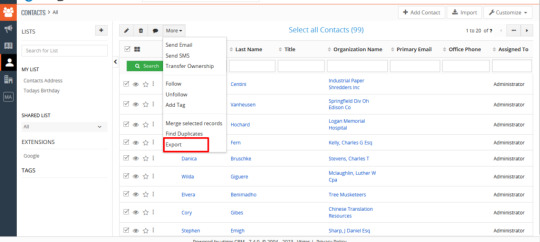
Step 6: Choose any one of the below options based on your business needs
Export Selected records
Export data on the current page
Export all data
Step 7: Finally click on Export Contacts.
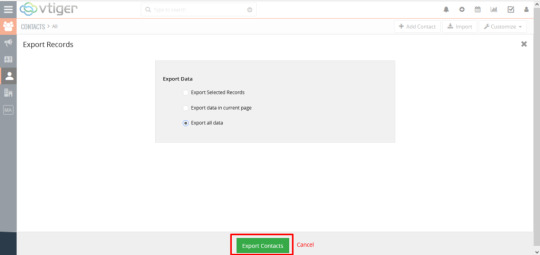
Now all your Vtiger contacts have been exported in a .csv format. Follow the steps explained above to export all the records from all the modules in Vtiger CRM.
Once done with exporting all the required modules, we now move on to the migration process.
Note:
If you are exporting a record in which organization and deals are related then it will be prefixed as accounts in the exported .csv file. For example, all my contacts are related to the organization name. In the exported .csv of my contacts module, the organization name is prefixed with the term Accounts.

Here the term Accounts refers to the Organisation whereas the term Deals refers to the Potentials.
Let’s Import all the exported Vtiger records into your Zoho CRM
In Vtiger CRM you need to export each module one by one. But in the Zoho CRM, we have a migration wizard where we can import all the modules at once.
Step 1: Sign in your Zoho account
Step 2: Migration Wizard
Navigate to Settings and select Import on the Data Administration.
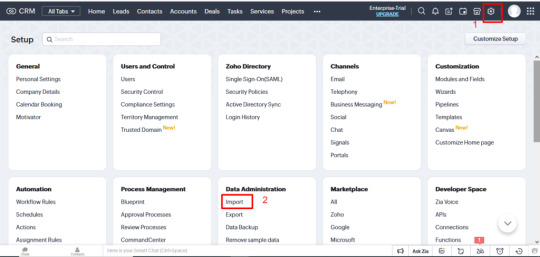
You will be landed on the Zoho Migration Wizard.
As Vtiger CRM is not listed, select “Other CRM”.
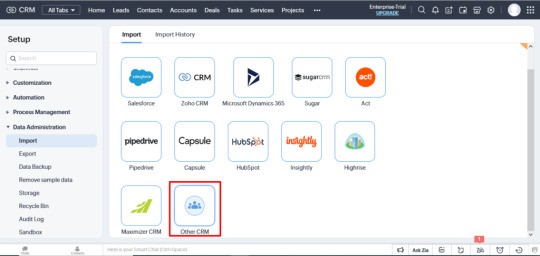
Now enter the name of your source as Vtiger. And Click on Continue
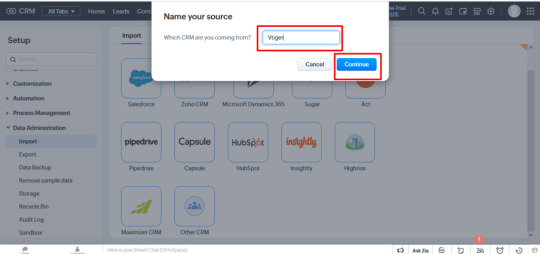
Step 3: Now it’s time to upload all the exported files from Vtiger
You can drag and drop or browse the exported Vtiger files.
Here only .csv files are supported.
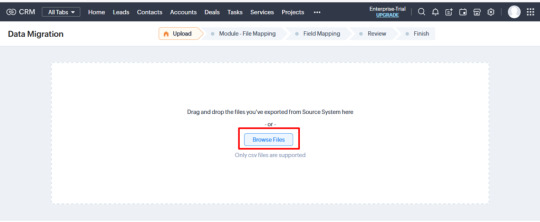
Browse all the CSV exported files of all the Vtiger modules one by one.
Once finish uploading files of all the modules, click on Next.
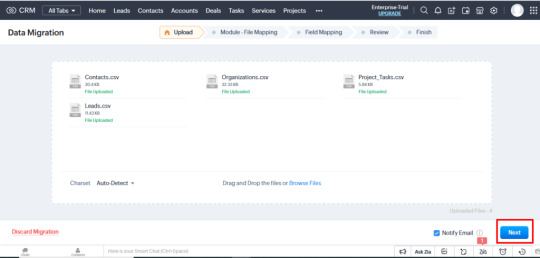
Now Zoho CRM will process your data. The processing time will depend on the file size /number of files.
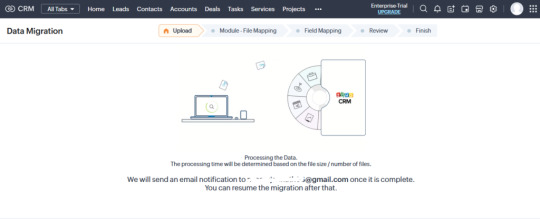
Step 4: Module- File Mapping
After processing all the files, it will lead to the tab Module- File Mapping. Here all the mapped files and unmapped files are displayed.
Based on the file names in Zoho CRM, the majority of Standard modules will automatically become associated with the system.
You can map all the unmapped fields with their related Zoho fields in the module widget. (For example, the Organization Module in Vtiger CRM is referred to as Accounts in Zoho CRM. And Project Tasks are referred to as Tasks).
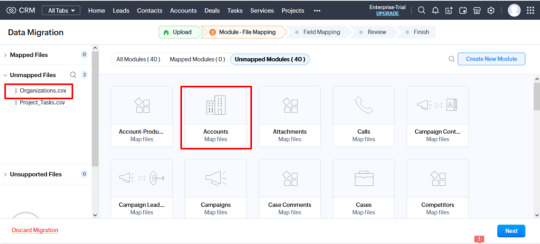
Once you map all the fields, click on Next.
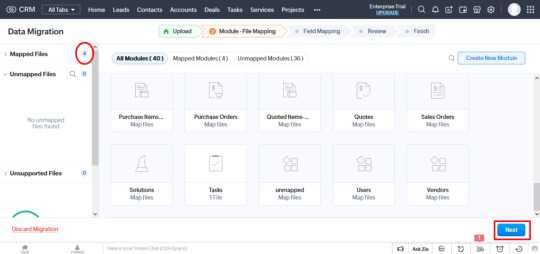
Note:
Creating Custom Modules: In case you are having files that are unmapped, then create a folder by clicking on the Create New Module button and add the appropriate files to that module.
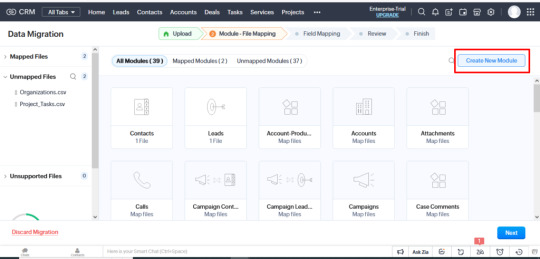
If you have to map your custom modules then you are provided with two options:
Your file will move to the unmapped section and ask for the suggestion. When you click OK, your custom module will be created.
Based on your custom file, you can also create a custom module from unmapped.
Now click on Next.
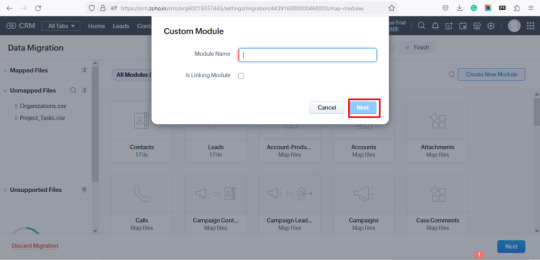
Step 5: Field Mapping
Map all the fields of mapped modules one by one with the related Zoho Fields.
Refer to the table above for the mandatory fields of all the modules. All the mandatory fields should be mapped for the succeeding action.
Once you mapped all the fields of all the mapped modules click on the Save and Next button.
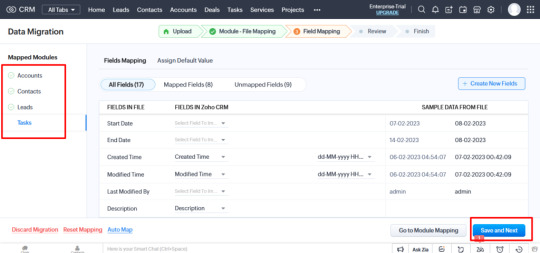
You can also add new fields for your essential modules or custom module by clicking on Create New Fields.

Now you can select the fields for which you want to create the custom fields.
Map all the fields and choose the appropriate Field type from the drop-down corresponding to the desired field.
Once selected all the field types, click on Create.
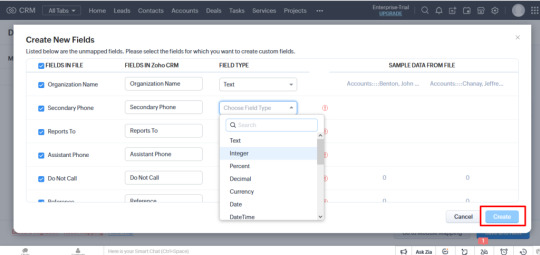
Step 6: Review your files
The Review tab displays all the modules that are going to migrate, the Number of Mapped fields, number of unmapped fields. You can easily review from here whether all the modules are included properly, the number of files, mapped fields, and unmapped fields.
If you find anything went wrong, then move back to the process, make the changes you need, and come back to the migration.
When you are done with all the data provided click on Start Migration.
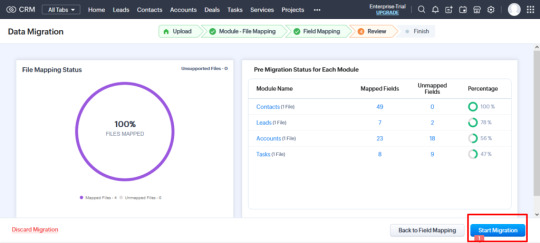
Step 7: Finish Migration
The Data Migration Process will start. It will display all the module names, the Status of migration related to the particular module, the number of records added and skipped, and the total records of each module.
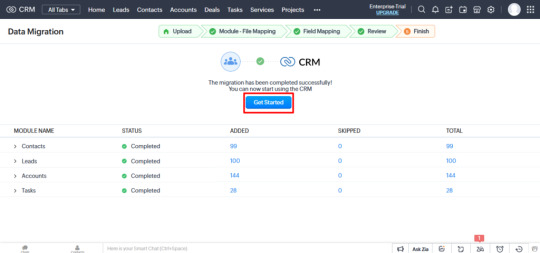
That’s it. Your records are safely migrated to the Zoho CRM. Now you can get started with your business activities with the new Zoho CRM.
Post-Migration- Double-check the migrated records
After you’ve taken the time and effort to migrate your data, make sure to take the extra step of verifying that everything went as expected. Going through the process of examining the data for any irregularities or inconsistencies helps you ensure a smooth transition and can save you from headaches down the road. Don’t trust the migration process blindly, double-check it! Make sure the data looks exactly as it should, that all addresses, names, and dates are correct, and that there are no formatting issues. With this extra bit of diligence, you can rest assured that your data has been successfully transferred.
Summing Up
Migrating from Vtiger CRM to Zoho CRM can be a daunting task, but it doesn’t have to be. With the right tools, support, and guidance, you can easily and quickly transition your data from Vtiger CRM to Zoho CRM. Not only will you enjoy Zoho’s advanced features and integrations, but you’ll also be able to stay organized and up-to-date with the latest technologies.
Though you can manually migrate all records from Vtiger CRM to Zoho CRM, it takes a lot more time, effort and resources to plan, manage, review, and follow up the migration process. It is ok to migrate manually if you have limited files. But in the case of migrating huge files, it is hard to analyze and review “Whether all the records have migrated safely”. There’s room for confusion here.
If you’re looking to migrate from Vtiger to Zoho CRM without losing data? Look no further! We offer a safe and secure migration service that ensures no data loss during the transition. Our team of experts will help you make the switch quickly and easily, so you can focus on what matters most – growing your business. We understand that data loss is a major concern for businesses, so we have developed a secure and reliable migration process that guarantees no data will be lost during the transition.
If you need the best customization and migration of Zoho CRM? You can contact us at [email protected] We provide efficient technical support for migrating your bulk data. We are responsible for the efficient data transfer from your Vtiger CRM to Zoho CRM.
Don’t wait any longer – make the switch to Zoho CRM today with our no-data-loss migration service!
#zohocrm#vtigercrm#crm#crmintegration#migration#crm software#crmdata#crmmigration#crm extensions#crm integration#blog post#tumblog
0 notes
Text
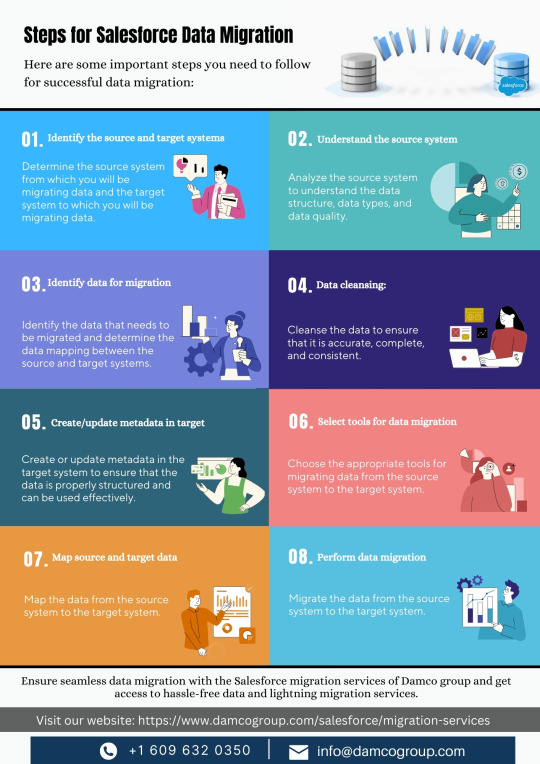
Salesforce Data Migration?
🚀 Planning a Salesforce Data Migration? Follow these crucial steps for success! 🔄🔍 Don't miss out on a seamless transition! Ready to elevate your data migration game? 🌐 Explore our comprehensive guide for a smooth Salesforce data migration journey!
👉 https://www.damcogroup.com/salesforce/migration-services
#DataMigration #SalesforceMigration #CRMData #DataManagement #DataIntegration #SalesforceSuccess #CloudMigration #TechMigration #BusinessData
0 notes
Photo

CRM software provides a host of benefits for your business and customers! These include streamlined data management, in-depth reporting capabilities and optimal workflow capabilities.
🌐 https://redskysoftware.net/crm-provider-in-bahrain/
0 notes
Photo

What is #CRMData Maintenance and How It Affects #B2B #Marketing https://snip.ly/ellc55
0 notes
Photo
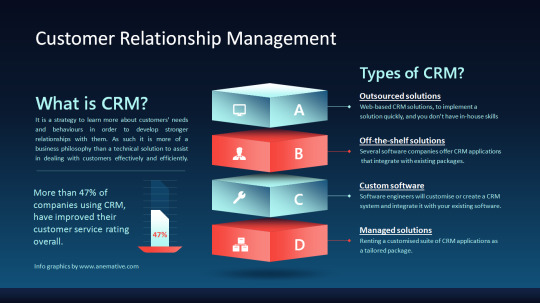
For infographic content like this, visit www.anemative.com #infographics #crmsoftware #crmintegration #crmtools #crm #crmprogrammanagement #crmdata #crmimplementation #typesofcrm #crmexperts
0 notes
Text
Apprentice Microsoft CRM Technical Consultant
France Furlong, Great Linford, Great Linford, Milton Keynes, Buckinghamshire MK14 5EH, UK Firebrand Training We're a CRM consultancy specialising in the Microsoft Dynamics CRM for the Office 365 platform. We are based in Milton Keynes and provide CRM consultancy, implementation, migration and Microsoft Dynamics CRM training services. As a Microsoft CRM Technical Consultant, your job includes: Handling support issues and resolving technical enquiriesCustomisation and configuration of Microsoft Dynamics CRMData MigrationReport developmentCRM Requirements Analysis and System DesignCustomisation and Configuration of Microsoft Dynamics and associated applicationsData migration of legacy applications into Microsoft DynamicsReport & Document DevelopmentEnd and key user trainingOngoing support What experience and skills do I need? You don`t need loads of professional experience in IT. However, you`ll need at least five GCSEs (or equivalent) at Grade C or above including Maths, English and IT / Science. Desirable Knowledge & Experience General experience or desire to learn IT skillsExperience in products in the Microsoft stack e.g. Windows, SQL, Office products and in particular good Excel skills.Knowledge of HTML, Java Script, .NETMicrosoft infrastructure e.g. servers and networking Your Accelerated training programme Firebrand offers a unique Higher Level 4 IT Apprenticeship scheme. We provide the fastest award-winning IT training and certifications with on-going support - all with the ultimate goal of securing a long-term IT career. During your two-year programme, Firebrand provides residential training at our distraction-free training centre. Our accelerated training means you'll achieve certifications with partners like CompTIA, ITIL and Microsoft faster, giving you more time to put your new skills into practice within a professional working environment. You'll also be recognised by the British Computer Society (BCS) for entry onto the register of IT Technicians, confirming SFIA level 3 professional competence. Future career prospects By working hard and demonstrating your ability, drive and commitment throughout your 24 month apprenticeship scheme, upon completion you will be offered a permanent contract ensuring you have further opportunities to continue growing within this exciting organisation. from Youth In Jobs https://youthinjobs.co.uk/job/31825/apprentice-microsoft-crm-technical-consultant/
0 notes
Video
youtube
(со страницы SugarCRM to Salesforce Migration: Delve Your Business Success)
0 notes